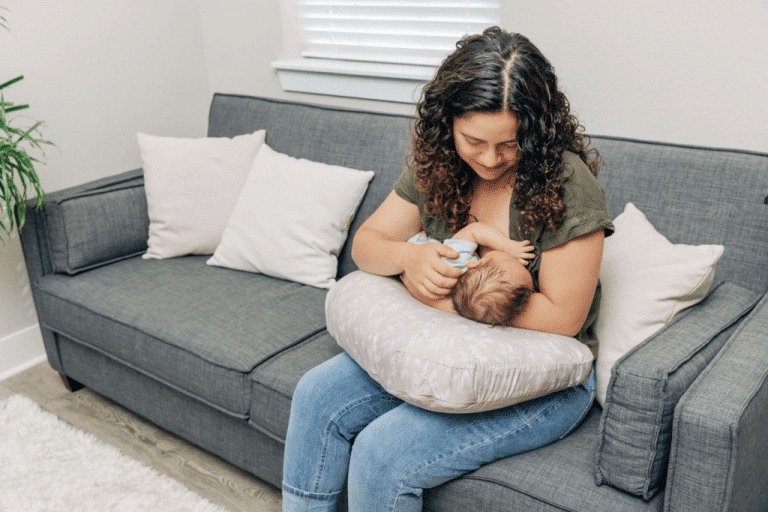Ever spent the night with tiny feet kicking your back and little hands grabbing your face?
Are you ready to reclaim your bed after months (or years) of co-sleeping with your toddler? You’re not alone!
While those snuggly moments are precious, many parents reach a point where separate sleep spaces become necessary for everyone’s well-being.
The good news? Moving your 2-year-old to their own bed isn’t just about getting your personal space back- it often leads to better sleep quality for your child, too.
Without the distraction of parents moving around, toddlers typically sleep more soundly, leading to improved daytime moods. Want to transition but feeling uncertain about how to start?
Let’s get into the process that makes this milestone smoother for everyone involved.
Why Sleep Training Your Toddler is Important?
Transitioning your 2-year-old from co-sleeping to independent sleep creates valuable benefits for the entire family.
- Enhanced sleep quality for your child – Without parental movements, position changes, or sleep sounds disturbing their natural sleep cycles.
- Significantly improved daytime behavior – Well-rested toddlers demonstrate better emotional regulation, extended attention spans, and improved learning capabilities.
- Critical self-soothing skill development – Children learn to manage their own comfort and emotions, building confidence and independence
- Restored parental sleep patterns – Enjoy uninterrupted rest without midnight kicks, covers being pulled away, or whispered demands
- Reclaimed adult space and relationship time – Reestablish your bedroom as a place for privacy, conversation, and connection with your partner
Research shows that children who learn healthy sleep habits early tend to maintain better sleep patterns throughout childhood and adolescence.
The short-term challenges of sleep training are outweighed by the long-term benefits of establishing consistent, independent sleep routines that support overall family well-being.
When to Transition from Co-Sleeping?
There’s no magical age when co-sleeping becomes a problem. Some families happily co-sleep for years, while others are counting down the days until they can reclaim their mattress!
So At What Age Should a Toddler Stop Sleeping with Their Parents?That said, around age two is often a sweet spot for transition. At this age, kids can understand simple explanations but haven’t become too set in their sleep habits.
Look for these readiness signs:
- Your toddler sometimes sleeps alone for the first part of the night
- They’re showing interest in their own room or “big kid” things
- Everyone’s sleep is suffering in the family bed
- You’re ready for the change (this matters too!)
Parents often share that waiting too long can make the transition harder.
What to Do with Separation Anxiety of Co-Sleeping?
Here’s the thing about separation anxiety: it’s completely normal. At around 18 months to 2.5 years, many toddlers go through a phase where they’re extra clingy and want reassurance that you’re nearby.
Co-sleeping can sometimes mask these feelings rather than help children work through them.
When toddlers learn to fall asleep independently, they build confidence in their ability to be okay without you right beside them—a valuable skill that extends beyond bedtime.
One pediatric sleep specialist explains it this way: “Learning to sleep alone is like learning to ride a bike. There might be some wobbles and tears at first, but the pride that comes with mastering this skill is worth it.”
Sleep Training Methods for 2-Year-Olds
Transitioning your toddler from co-sleeping requires a structured approach.
These proven methods can help you make the switch successfully, depending on your child’s temperament and your approach to parenting.
1. Chair Method
Sit next to your toddler’s bed while they fall asleep, gradually moving the chair farther away each night until you’re outside the door.
Best For: Former co-sleepers, children needing physical reassurance, and parents preferring a gradual approach.
Expected Timeline: 1-2 weeks for initial progress, 2-3 weeks for completion.
2. Sleep Lady Shuffle
Similar to the Chair Method but with slower transitions, staying closer to the bed for more nights and moving the chair in smaller increments.
Best For: Highly sensitive children, kids with separation anxiety, and parents wanting to minimize tears.
Expected Timeline: 2-3 weeks for initial progress, up to 4 weeks for completion.
3. Ferber Method (Check & Console)
Put your child to bed awake and return for timed check-ins at progressively longer intervals (e.g., 3, 5, 10 minutes).
Best For: Children who get more upset with parent presence, kids needing brief reassurance, and parents seeking faster results.
Expected Timeline: 3-7 days for initial progress, 1-2 weeks for completion.
4. Camping Out Method
Sleep in your child’s room for a few nights, then transition to sitting in a chair and eventually brief check-ins.
Best For: Former co-sleepers, children with strong attachment needs, and parents seeking a gradual transition.
Expected Timeline: 1-2 weeks for the initial phase, 2-3 weeks for completion.
Key Tips for Success with 2-Year-Olds
- Provide Explanations: “We sleep in our own beds so everyone gets good rest” is more effective than “because I said so.”
- Use Visual Aids: Sticker charts and reward systems can motivate your toddler.
- Celebrate Independence: Praise your child for their efforts in sleeping alone.
- Be Consistent: The method matters less than being consistent in your approach.
How Long Does It Take?
Let’s be real—sleep training a toddler who’s used to co-sleeping isn’t an overnight fix. Most families see significant improvement within 1-2 weeks, but complete adjustment might take 3-4 weeks.
Factors that affect the timeline include:
- Your child’s temperament: Strong-willed children often take longer.
- Your consistency: Giving in occasionally resets the clock.
- Previous sleep associations: The stronger the association with parent presence, the longer the adjustment.
- Method chosen: Gentler methods typically take longer but may cause less resistance.
As one sleep consultant puts it: “The first three nights are usually the hardest, the first week is tough, the second week shows improvement, and by week three, you’re seeing the light at the end of the tunnel.”
When to Consult a Sleep Expert
While most sleep training challenges can be resolved at home, some situations may benefit from professional guidance.
Recognizing when to reach out for additional support is an important parenting skill.
Consider reaching out for professional support if:
- Sleep problems persist for more than 2-3 weeks of consistent effort
- Your child seems unusually anxious or afraid
- There are signs of sleep apnea or unusual breathing patterns
- Your child’s daytime behavior has significantly worsened
- Your own mental health is suffering significantly
Pediatricians, family doctors, and sleep specialists can offer personalized advice and rule out medical issues.
It’s a Wrap!
Whew! Sleep training a co-sleeping toddler isn’t always a smooth ride, but the destination is so worth it. Stick with it, even when it gets tough!
Your most powerful tools?
Consistency, patience, and a good sense of humor.
That same kid who’s clinging to your leg at bedtime now might be proudly showing off their “big kid bed” to visitors in just a few weeks.
Remember, there’s no one-size-fits-all approach. Trust your gut, adjust as needed, and celebrate every tiny win along the way. The first full night in their own bed deserves a happy dance!
Before you know it, everyone will be sleeping better—just not in a tangled heap together. Sweet dreams!
Frequently Asked Questions (FAQs)
Is It Too Late to Sleep Train a 2 Year Old?
It’s not too late to sleep-train a 2-year-old. This age is actually an excellent time to transition, as toddlers can understand explanations and are developing independence.
How Long Do I Let My 2-Year-Old Cry It Out?
Avoid extended crying. Choose a gentle method, such as the Chair Method or Sleep Lady Shuffle, that provides comfort while gradually promoting independent sleep.
What are the Psychological Effects of a Child Sleeping with Parents?
Co-sleeping can impact child development. Independent sleep helps toddlers build confidence, improve sleep quality, and develop crucial self-soothing skills.













